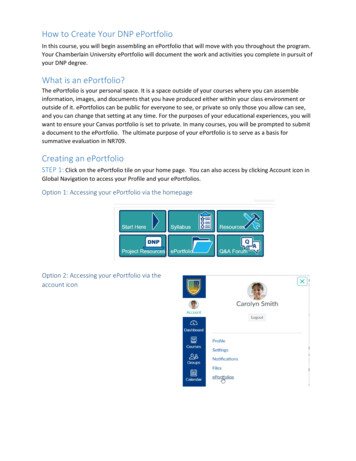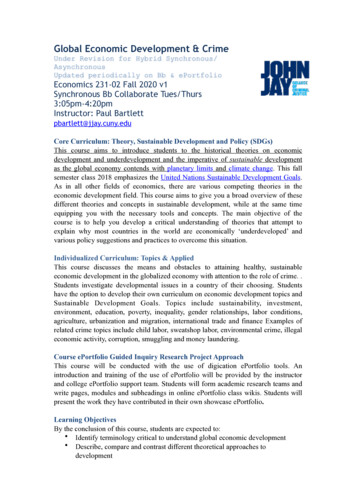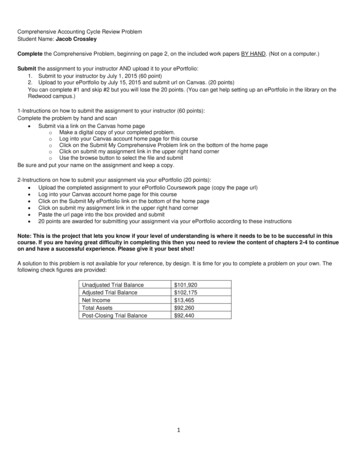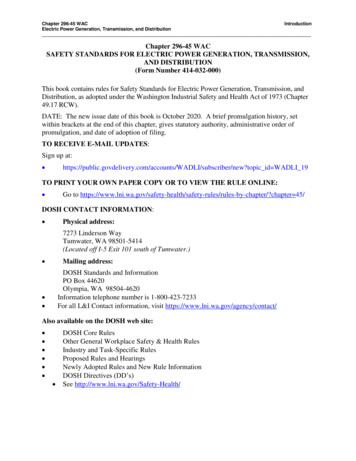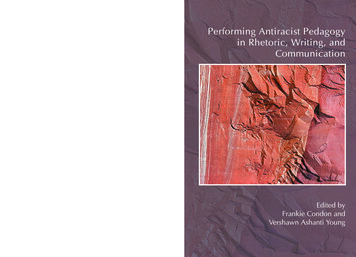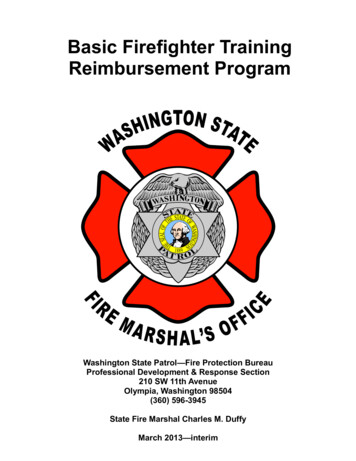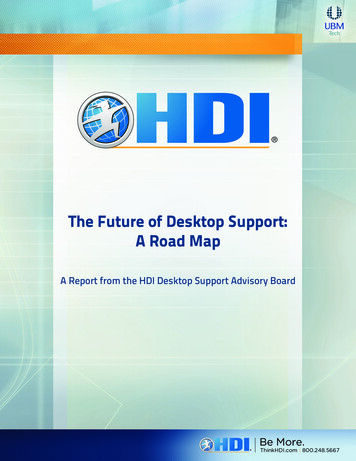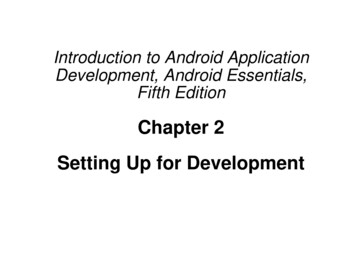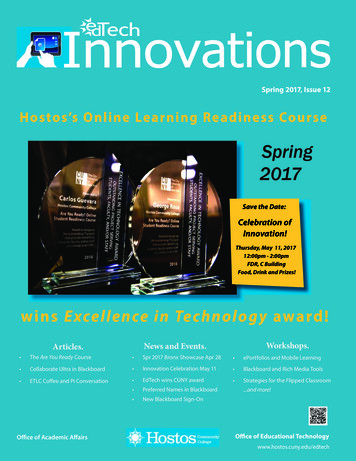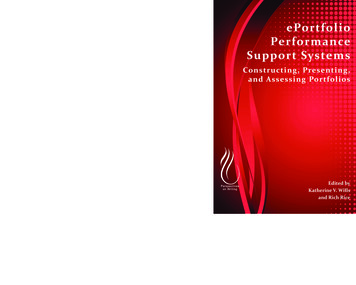
Transcription
ePortfolioPerformanceSupport SystemsConstructing, Presenting,and Assessing PortfoliosEdited byKatherine V. Willsand Rich Rice
EPORTFOLIOPERFORMANCE SUPPORTSYSTEMS: CONSTRUCTING,PRESENTING, AND ASSESSINGPORTFOLIOS
PERSPECTIVES ON WRITINGSeries Editor, Susan H. McLeodThe Perspectives on Writing series addresses writing studies in a broad sense.Consistent with the wide ranging approaches characteristic of teaching andscholarship in writing across the curriculum, the series presents works that takedivergent perspectives on working as a writer, teaching writing, administeringwriting programs, and studying writing in its various forms.The WAC Clearinghouse and Parlor Press are collaborating so that these bookswill be widely available through free digital distribution and low-cost print editions. The publishers and the Series editor are teachers and researchers of writing, committed to the principle that knowledge should freely circulate. We seethe opportunities that new technologies have for further democratizing knowledge. And we see that to share the power of writing is to share the means forall to articulate their needs, interest, and learning into the great experiment ofliteracy.Other Books in the SeriesCharles Bazerman and David R. Russell (Eds.), Writing Selves/Writing Societies(2003)Gerald P. Delahunty and James Garvey, The English Language: From Sound toSense (2009)Charles Bazerman, Adair Bonini, and Débora Figueiredo (Eds.), Genre in aChanging World (2009)David Franke, Alex Reid, and Anthony Di Renzo (Eds.), Design Discourse:Composing and Revising Programs in Professional and Technical Writing(2010)Martine Courant Rife, Shaun Slattery, and Dànielle Nicole DeVoss (Eds.),Copy(write): Intellectual Property in the Writing Classroom (2011)Doreen Starke-Meyerring, Anthony Paré, Natasha Artemeva, Miriam Horne,and Larissa Yousoubova, Writing in Knowledge Societies (2011)Andy Kirkpatrick and Zhichang Xu, Chinese Rhetoric and Writing: AnIntroduction for Language Teachers (2012)Charles Bazerman et al. (Eds.), International Advances in Writing Research:Cultures, Places, Measures (2012)Chris Thaiss et al. (Eds.), Writing Programs Worldwide: Profiles of AcademicWriting in Many Places (2012)Mike Duncan and Star Medzerian Vanguri, The Centrality of Style (2013)
EPORTFOLIOPERFORMANCE SUPPORTSYSTEMS: CONSTRUCTING,PRESENTING, AND ASSESSINGPORTFOLIOSEdited by Katherine V. Wills and Rich RiceThe WAC Clearinghousewac.colostate.eduFort Collins, ColoradoParlor Presswww.parlorpress.comAnderson, South Carolina
The WAC Clearinghouse, Fort Collins, Colorado 80523-1052Parlor Press, 3015 Brackenberry Drive, Anderson, South Carolina 29621 2013 by Katherine V. Wills and Rich Rice. This work is released under a Creative CommonsAttribution-Noncommercial-No Derivative Works 3.0 United States License.ISBN 978-1-64215-049-0 (pdf ) 978-1-64215-050-6 (epub) 978-1-60235-441-8 (pbk.)DOI 10.37514/PER-B.2013.0490Produced in the United States of AmericaLibrary of Congress Cataloging-in-Publication DataePortfolio Performance Support Systems: Constructing, Presenting, and Assessing Portfolios /edited by Katherine V. Wills and Rich Rice.p. cm. -- (Perspectives on writing)Includes bibliographical references.ISBN 978-1-60235-441-8 (pbk.: acid-free paper) -- ISBN 978-1-60235-442-5 (hardcover:acid-free paper) -- ISBN 978-1-64215-049-0 (pdf ) -- ISBN 978-1-64215-050-6 (epub)1. Electronic portfolios in education. 2. Academic achievement--Evaluation. 3. Englishlanguage--Rhetoric--Study and teaching (Higher) I. Wills, Katherine V. 1957- II. Rice,Richard Aaron.LB1029.P67E69 2013378.166--dc232013019920Copyeditor: Don DonahueDesigners: Mike PalmquistSeries Editor: Susan H. McLeodThe WAC Clearinghouse supports teachers of writing across the disciplines. Hosted by Colorado State University, it brings together scholarly journals and book series as well as resourcesfor teachers who use writing in their courses. This book is available in digital format for freedownload at wac.colostate.edu.Parlor Press, LLC is an independent publisher of scholarly and trade titles in print and multimedia formats. This book is available in paperback, cloth, and Adobe eBook formats from Parlor Press at www.parlorpress.com. For submission information or to find out about Parlor Presspublications, write to Parlor Press, 3015 Brackenberry Drive, Anderson, South Carolina 29621,or e-mail editor@parlorpress.com.
CONTENTSAcknowledgements 3Introduction 5Katherine V. Wills and Rich RiceSection 1: Systematic Performance Support Systems 17Chapter 1. Postmodernism, Palimpsest, and Portfolios: Theoretical Issues inthe Representation of Student Work 19Kathleen Blake YanceyChapter 2. The Hypermediated Teaching Philosophy ePortfolio PerformanceSupport System 41Rich RiceChapter 3. The Social ePortfolio: Integrating Social Media and Models ofLearning in Academic ePortfolios 57Lauren F. KleinSection 2: Constructing the Bridge 75Chapter 4. ePorts: Making the Passage from Academics to Workplace 77Barbara J. D’Angelo and Barry M. MaidChapter 5. What Are You Going to Do With That Major? An ePortfolio asBridge from University to the World 89Karen Ramsay Johnson and Susan KahnChapter 6. Career ePortfolios: Recognizing and Promoting EmployableSkills 109Karen BonsignoreSection 3: Presenting Interactive Designs 121Chapter 7. Showcase Hybridity: A Role for Blogfolios 123Geoffrey Middlebrook and Jerry Chih-Yuan SunChapter 8. Accessible ePortfolios for Visually-Impaired Users: Interfaces,Designs, and Infrastructures 135Sushil K. OswalChapter 9. From Metaphor to Analogy: How the National Museum of theAmerican Indian can inform the Augusta Community Portfolio 155Darren Cambridgev
ContentsSection 4: Authentic Assessment Tools and Knowledge Transfer 181Chapter 10. Mapping, Re-Mediating, and Reflecting on Writing ProcessRealities: Transitioning from Print to Electronic Portfolios in First-YearComposition 183Steven J. Corbett, Michelle LaFrance, Cara Giacomini,and Janice FournierChapter 11. ePortfolios as Tools for Facilitating and Assessing KnowledgeTransfer from Lower Division, General Education Courses to UpperDivision, Discipline-specific Courses 205Carl WhithausChapter 12. Balancing Learning and Assessment: A Study of Virginia Tech’sUse of ePortfolios 221Marc Zaldivar, Teggin Summers, and C. Edward Watsonvi
EPORTFOLIOPERFORMANCE SUPPORTSYSTEMS: CONSTRUCTING,PRESENTING, AND ASSESSINGPORTFOLIOS
ACKNOWLEDGEMENTSePortfolios are considered “authentic assessment” learning tools. Reflectingover the process and the product built for end task, capstone, or assessmentpurposes can be enormously instructive. Working with contributors to edit thiscollection of essays; gathering advice from colleagues at both Texas Tech University and Indiana University Purdue University Columbus; bouncing ideasoff members of our professional communities such as those in the fields ofComputers and Writing, Writing Program Administration, Technical Communication, Rhetoric, First-Year Experience, Secondary English Education, andAssessment; discussing new directions and new emerging technologies withresearchers in assessment, website design, interaction design, social media, mobile media, communication, and assessment areas; as well as working with thefabulously innovative people at The WAC Clearinghouse and Parlor Press, hasbeen incredibly valuable to us. We want to thank Susan H. McLeod especially,the series editor, whose tireless work with our project is a model for all editors.Publishers Mike Palmquist with The WAC Clearinghouse and David Blakesleywith Parlor Press have both been very generous with their feedback and timeand direction. Thank you, Kathy Yancey and Barbara Cambridge and DarrenCambridge, for the amazing work you’ve done on portfolios over the years.Your work is a model for anyone and everyone working in this area. Thank you,Kanika Batra, for your editing work and support with the project. Further, wethank our anonymous peer reviewers, and we thank the many graduate studentsin training who reviewed and helped offer style and editing advice as part oftheir own coursework and development as scholars, including, specifically, Jessica Badger (Texas Tech University), Christopher Andrews (Texas Tech University), Melanie Doulton (Texas Tech University), Deborah Fontaine (NorthwestFlorida State College), Dan Lovejoy (Texas Tech University), Jon Ostrowski(Texas Tech University), Richard Rabil (Texas Tech University), Rhonda Stanton (Texas Tech University), and Xiling Wang (Texas Tech University). Finally,as with every project of this scope, the many students who have shared theirthinking and ideas through our courses, through the courses of our contributors, through the courses cited in the scholarship of this text, and through thecontinuation of ideas from this collection, we are indebted and thank you. Justas the construction, presentation, and assessment of any ePortfolio is an authentic learning opportunity, the creation of this text and its continuation throughCreative Commons licensing has been a wonderful learning experience. Thislive text will continue to grow. Please review additional examples and the on-3
Acknowledgementsgoing programs discussed in this collection online through The WAC Clearinghouse’s Open-Access Books page (http://wac.colostate.edu/books).4
INTRODUCTIONKatherine V. WillsIndiana University Purdue University ColumbusRich RiceTexas Tech UniversityInstitutions of higher learning have dedicated much energy and many resources to assessment measurements and standards through individual tools,through high-stakes testing, and through ePortfolio management systems. AnePortfolio is a selected collection of work presented electronically. An electronicperformance support system, specifically, is an integrated electronic environment designed to reduce complexity in order to make sense of things, to provide employee performance information in order to foster improvement, and toprovide workers with a decision support system in order to maximize productivity. As higher education continues to learn from efficiencies and new technologies in the workplace that refine performance measurement, study knowledgetransfer and Web 2.0 tools (Gerben, 2009), and develop viable and sustainableproducts through interaction theory and website design principles, this collection of essays from knowledgeable scholars and practitioners of ePortfolioshelps foster increased understanding of intersections between ePortfolio composing, presentation, and assessment in the academy and workplace, including ideas for embracing electronic performance support systems. Ideas and thediscussion related in this collection published by the WAC Clearinghouse areextended online through Creative Commons licensing, as well. Please considerpurchasing the print version, but also freely link to and share materials in theonline version.Essays in this collection ask readers to consider ways in which ePortfolios,as distinguished from non-electronic portfolios, facilitate sustainable and measureable writing-related student development, assessment and accountability,learning and knowledge transfer, principles related to universal design for learning, just-in-time support, interaction design, and usability testing. The collection contributes to recent scholarship on ePortfolios and provides new dimensions to the field of portfolio development in the academic and in workplaces.Traditionally, portfolios have been considered valuable tools because in additionto embracing principles of validity and reliability as assessment measurements,they enable students to continue to learn as they construct their portfolios.Portfolios have specific audiences—most traditionally a program or a teacherDOI: https://doi.org/10.37514/PER-B.2013.0490.1.35
Introductionin an institution. But institutions work to prepare students for the workplace(including academic workplaces), and the workplace demands much differentforms of performance and support measurements. ePortfolios should be designed with scalability and potential workplace applications in mind.The collection is categorized into four sections each with three essays (chapters) that conduct an intertexual discussion and point to possibilities and gapsfor ePortfolios future discussion.1. SYSTEMATIC PERFORMANCE SUPPORT SYSTEMSWe open the discussion with Kathy Yancey’s seminal article, “Postmodernism, Palimpsest, and Portfolios: Theoretical Issues in the Representation of Student Work,” which is reprinted with permission from the National Councilof Teachers of English. Originally published in College Composition and Communication in 2004, Yancey’s piece situates portfolios as reflective “exercises inremediation” in a public space. Classrooms, too, are public spaces.Throughout the collection, contributors Rice, Ramsay Johnson and Kahn,Cambridge, Corbett et al., and others expand on Yancey’s concept of how ePortfolios can iteratively resituate and reconstitute ePortfolio artifacts into newinterpretive understanding. This ability of ePortfolios to not only reproduce,but also to reformulate meanings across time and space lends ePortfolios theiradditive possibilities. Adding one plus one artifact does not equal two, but morethan two because of the variety of possible interpretations. The intentionalgathering and remixing of artifacts lends to the viability of ePortfolios acrossworkplaces and lives, as Yancey alluded to in her 2004 CCC article. We felt wewould be remiss if we did not launch this collection with Yancey’s piece becausewe knew her work would be foundational to the ePortfolio conversations ofthis collection. And, as Yancey predicted in her article and as this collectionshows, digital portfolios are evolving nationally and internationally and attention should be paid to the intentionality of the development.Yancey is Kellogg W. Hunt Professor of English and Distinguished ResearchProfessor at Florida State University, where she directs the Graduate Programin Rhetoric and Composition (http://ncte2008.ning.com/profile/kathleenyancey). She has served in several national leadership roles, including Presidentof the National Council of Teachers of English; Chair of the Conference onCollege Composition and Communication; and President of the Council ofWriting Program Administrators. In January 2013, she assumed the Presidencyof the South Atlantic Modern Language Association. She also co-founded andco-directs the Inter/National Coalition for Electronic Portfolio Research, which6
Introductionhas brought together over 60 institutions from around the world to documentthe learning represented in electronic portfolios. Editor of the flagship journal of writing studies College Composition and Communication, Yancey has authored or co-authored over 70 articles and book chapters and authored, edited,or co-edited eleven scholarly books, including Portfolios in the Writing Classroom(1992), Reflection in the Writing Classroom (1998), Situating Portfolios (1997b),Delivering College Composition: The Fifth Canon (2006), Electronic Portfolios 2.0:Emergent Research on Implementation and Impact (2009), and the forthcoming co-authored Contexts of Writing: Transfer, Composition, and Sites of Writing,which is a study of the transfer of writing knowledge and practice in college.Rich Rice follows Yancey’s principles and core values of representation in“The Hypermediated Teaching Philosophy ePortfolio Performance SupportSystem.” Rice directs the Multiliteracy Lab in the Texas Tech University Department of English, and he teaches using ePortfolios both online and face-toface in the TTU Technical Communication and Rhetoric program. See http://richrice.com. He is a member of the Conference on College Composition andCommunication’s Committee on Best Practices for Online Writing Instruction. His recent articles are in the areas of new media knowledge creation, mobile medicine, basic writing and photo essays, remediated film, nontraditionalgraduate support systems, ePortfolios, and media labs. With Nedra Reynolds(2006a, 2006b) he has co-written the second editions of Portfolio Keeping andPortfolio Teaching. Reynolds is soon to release third editions. In this essay, Ricedraws on research in electronic performance support systems in order to pointout ways in which the traditional teaching philosophy essays fall short as a genreof invoking its intended audience and multiple purposes because of hypertextual and reflective exegeses similar to those in ePortfolios. He suggests that inorder to become an effective ePortfolio support system, the teaching philosophy should be taught and received as a networked performance space. In thissecond essay, Rice opens by expanding on Yancey’s belief that ePortfolios, likea palimpsest, can be “retooled.” Rice then hints at upcoming ideas in LaurenKlein’s essay that discusses how blurring the boundaries of social media andePortfolios can enhance classroom and workplace experiences. Furthermore,Rice elaborates on Carl Whithaus’ discussion later in the collection of teachingphilosophies as a “thirdspace” from Grego and Thompson (2008). ePortfoliosmultiply opportunities for presenting the self in diverse kairotic performancessuch as hypermediated teaching philosophies.Next, Lauren F. Klein details another systematic approach to academicportfolios using social media. Klein directs the portfolio program in the CityUniversity of New York’s Macaulay Honors College (http://macaulay.cuny.edu/eportfolios/lklein). She is an Assistant Professor in the School of Literature, Me7
Introductiondia, and Communication at the Georgia Institute of Technology, where she alsodirects the Digital Humanities Lab. Her essay, “The Social ePortfolio: Integrating Social Media and Models of Learning in Academic ePortfolios,” examinesrecent research in social networking. She points out how many users can applyePortfolio systems and social network sites in order to bridge the academy andother workplaces. What can an ePortfolio be? An ePortfolio can shapeshift intoalmost anything, according to Klein. Her essay closes Section 1 by movingreaders among Yancey’s foundations, Rice’s teaching philosophy constructions,and then Klein’s worlds of social networking: practical and creative, personaland social, textual and digital. This builds a foundation for the essays in Section2, Constructing the Bridge, which explores ePortfolio transitioning into nonacademic workplaces as sustainable academy-to-workplace programs, capstonecourses, and feedback loops that improve the ePortfolio experience and product.2. CONSTRUCTING THE BRIDGEThe first essay in this section is by Barbara D’Angelo and Barry Maid. “ePorts: Making the Passage from Academics to Workplace” builds on the ideathat ePortfolios can be useful for both individuals and systems by talking aboutePortfolios as passageway from demonstrating proficiencies and meeting programmatic outcomes to demonstrating entry-level skills in various workplaces.The essay situates perceived dichotomies of academic versus practical, and theoretical versus applied. A key finding in D’Angelo and Maid’s ePortfolio evaluation is that “direct instruction in tools or software” is a common shortcoming.How can teaching institutions serve many stakeholders? Ultimately, the authorsconclude teachers using ePortfolios must serve in their role as technical communication educators. Any institution rebuilding its use of ePortfolios wouldbenefit from this analysis of Arizona State University’s program. It serves asa technical communication bridge between the academy and the workplace.D’Angelo’s publications include several book chapters and articles on the useof outcomes for curriculum development and assessment and on informationliteracy. Maid founded the Technical Communication program at Arizona StateUniversity in 2000 and headed it for more than 10 years. His recent publications are in the area of information literacy, writing assessment, online education, and independent writing programs. Most recently, with Duane Roenand Greg Glau, he is co-author of The McGraw-Hill Guide: Writing for College,Writing for Life, currently in its 3rd edition (2012). Learn more about theseresearchers’ ongoing work at http://www.public.asu.edu/ bdangelo and http://www.public.asu.edu/ bmmaid.8
IntroductionNext, Karen Ramsay Johnson and Susan Kahn at Indiana University PurdueUniversity at Indianapolis (IUPUI) highlight their perspectives on challengesembedded in capstone projects. The essay connects the dots with English majors and professional programs transitioning to careers or further study. Similarto the previous essay regarding ASU, the authors relate work being done atIUPUI, including integration of ePortfolios with other adopters across campus.Johnson and Kahn show the evolution of their work in relation to work fromBarrett (2004), to matrices and webfolio work of Hamilton and Kahn (2009),to Zubizarreta (2009), and to Cambridge, Cambridge, and Yancey in Electronic Portfolios 2.0 (2009). This chapter continues a thread on reflective processin ePortfolios that runs through the work of Darren Cambridge. Whether inthe classroom or community, reflective process weaves through the collection.More than a case study of ePortfolios within the collection, Johnson and Kahn’spiece shares the reflective experiences of four English Capstone students using ePortfolios. The feedback loop between students and authors/researchersshows that the technology of ePortfolios may not resolve inherent pedagogicaland social problems. Readers are reminded that ePortfolios are always already“works-in-progress.” Johnson has given numerous presentations on ePortfoliosand their use in both Liberal Arts programs and in assessment. Kahn has published, presented, and consulted widely on faculty development, assessment,and electronic portfolios, including co-editing Electronic Portfolios: EmergingPractices in Student, Faculty, and Institutional Learning (2001). She currentlychairs the Board of Directors of the Association for Authentic, Experiential,and Evidence-Based Learning (AAEEBL), the international association for ePortfolio practitioners.See http://academicaffairs.iupui.edu/plans/ePort for morediscussion on IUPUI’s approachs.Karen Bonsignore in “Career ePortfolios: Recognizing and Promoting Employable Skills,” writes about “City Tech,” an organization that helps studentsprepare career ePortfolios. Bonsignore is Director of the New York City Collegeof Technology ePortfolio Project (http://eportfolio.citytech.cuny.edu). She hasoffered numerous presentations on various ePortfolio, assessment, and technology related topics including, most recently, “Comprehensive Support for aSuccessful ePortfolio Project,” “Designing an Effective Online eTutor WritingAssistance Program to Support Career ePortfolios at City Tech,” and “CareerePortfolios: A Showcase of Student Work.” This essay relies on student perspectives, but with the career ePortfolio and its multiple and diverse audiences inmind. Bonsignore’s text brings into sharp relief the public life of the ePortfolioas an artifact for the marketplace. These portfolios offer significant advantagesover traditional dossiers, including offering numerous versions. The programprepares students with competitive job market and graduate school admissions9
Introductionadvice. Thus, the three discussions in Section 2 about constructing bridges examine the nuanced interplay of outcomes, reflection, and audience in variety ofePortfolio capstone courses and community projects.3. PRESENTING INTERACTIVE DESIGNSGeoffrey Middlebrook from the University of Southern California and JerryChih-Yuan Sun from National Chiao Tung University begin “Showcase Hybridity: A Role for Blogfolios” with a powerful volley to the ePortfolio fieldabout the limitations of static approaches to ePortfolios. They encourage database-driven and more dynamic approaches to the ePortfolio imagination. Specifically, this chapter discusses a project at USC to implement a portfolio-basedsystem. Hybrid “blogfolios” can result in flexible research processes for personal, intellectual, and vocational benefits. Middlebrook and Chih-Yuan Sun evokeAli Jafari’s (2004) positioning of students as stakeholders at the “cyber-table.”Students and web bloggers do not only reproduce digital identity through content; their identity is developed through aesthetic, software, and media choices(Farmer, 2006). Chih-Yuan Sun has published journal and conference papers inthe areas of online teaching and learning, student motivation, electronic feedback devices, OpenCourseWare, and ePortfolios. Middlebrook is the recipient of numerous grants and awards, among them the University of SouthernCalifornia Provost’s Prize for Teaching with Technology. For more informationabout current work, see Middlebrook at y.cfm?pid 1003534, and Chih-Yuan Sun through http://blog.jerrysun.net and http://elearning-lab.nctu.edu.tw.Similarly, in “Accessible ePortfolios for Visually-Impaired Users: InterfacesDesigns, and Infrastructures,” author Sushil K. Oswal focuses on questionsof interface and content design in ePortfolios for blind users. The chapter isrelevant for those with other disabilities as well. Oswal’s research is anchoredin digital technology and the questions of accessibility for the disabled. Oswal established the First-Year Writing Portfolio Project at Middle TennesseeState University and the university’s newly-minted Ph.D. program has to dateresulted in three doctorate degrees on the topic of portfolios. Oswal receivedthe C. R. Anderson Award for the work on his doctoral study of an Environmental Taskforce in a Japanese-owned corporation. He is currently a Technical Communication faculty of an Interdisciplinary Program at the Universityof Washington, Tacoma, with additional appointments in the EnvironmentalStudies unit of his department and the Disability Studies unit of the Universityof Washington, Seattle. His discussion guides readers to Zaldivar, Summers,10
Introductionand Watson’s chapter regarding what constitutes effective ePortfolio productionand accessibility. For more information on Sushil K. Oswal’s current work, hil oswal.And the third chapter in this section comes from Darren Cambridge: “FromMetaphor to Analogy: How the National Museum of the American Indian caninform the Augusta Community Portfolio.” Cambridge’s latest books on ePortfolios are well-cited throughout this collection. Cambridge works for theAmerican Institutes for Research, and spends much time analyzing ePortfoliowork being done around the world. Cambridge explores the use of a specificmetaphor to suggest that the individual and the system must be better integrated. The metaphor he uses is that of a museum. Here, Cambridge studies theAugusta Community Portfolio project and uses details from the National Museum of the American Indian to suggest ePortfolio design must be highly interactive in order maximize effectiveness. Cambridge asks for a “balanced relationship between community ePortfolio authors and readers, developing design andcontent that both provides audiences with immediate value.” The demands ofpublic, academic, professional, and personal spaces should not override authentic literacy. This third section at once heralds, praises, and critically questionsthe value of interactivity of digital literacies. He co-leads the Inter/NationalCoalition for Electronic Portfolio Research; is third country coordinator for theEuroportfolio project funded by the European Union’s Lifelong Learning program; and serves on the board of the Association for Authentic, Experiential,and Evidence-Based Learning. He has developed technical specifications forIMS Global Learning Consortium and open source ePortfolio software throughthe Sakai Foundation. For more of Cambridge’s recent work, see Electronic Portfolios 2.0: Emergent Research on Implementation and Impact (2009), and Eportfolios for Lifelong Learning and Assessment (2010). Links can be found at http://ncepr.org/darren.4. AUTHENTIC ASSESSMENT TOOLSAND KNOWLEDGE TRANSFERIn the first essay of the last section, co-written by Steven J. Corbett, MichelleLaFrance, Cara Giacomini, and Janice Fournier, “Mapping, Re-Mediating, andReflecting on Writing Process Realities: Transitioning from Print to ElectronicPortfolios in First-Year Composition,” the authors describe conditions criticalto understanding how best practices are implemented. Specifically, they look atePortfolios in first-year composition at the University of Washington throughshifting attitudes, practices, and technological affordances. Academia, too, is11
Introductiona workplace. What results are enhanced by critical reflection, better understanding of learning processes, and a more spe
The WAC Clearinghouse and Parlor Press are collaborating so that these books will be widely available through free digital distribution and low-cost print edi - . (pdf) -- ISBN 978-1-64215-050-6 (epub) 1. Electronic portfolios in education. 2. Academic achievement--Evaluation. 3. English language--Rhetoric--Study and teaching (Higher) I .
